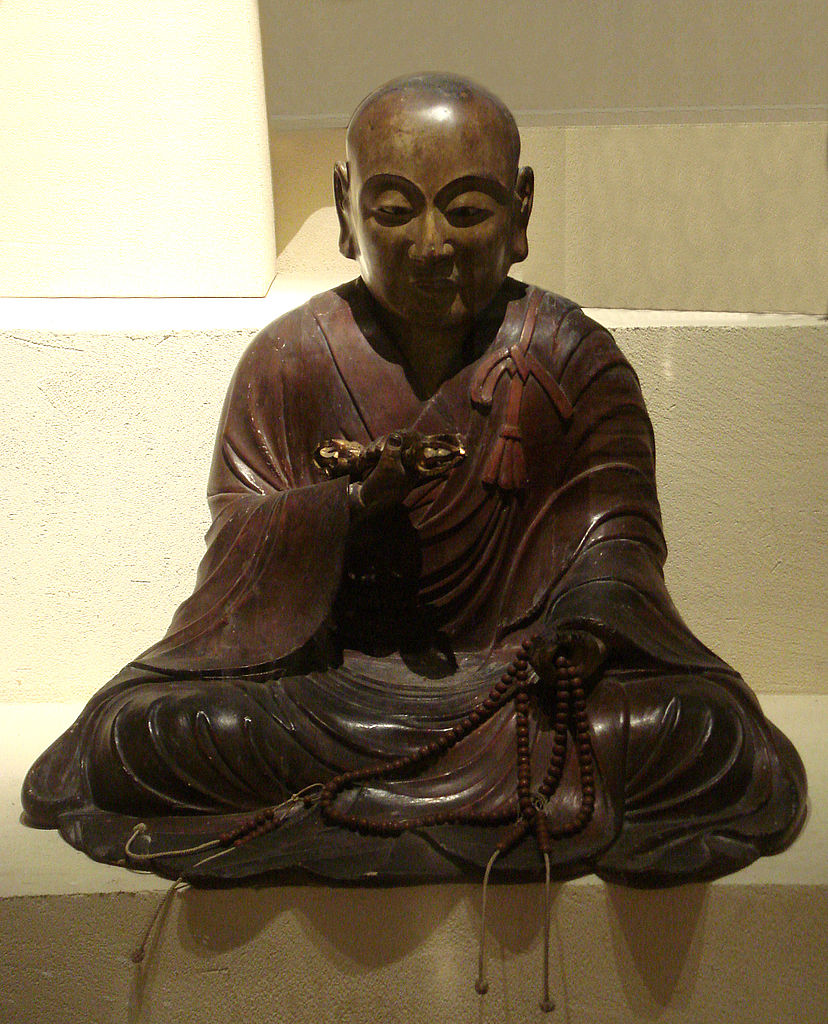
Scholar and philosopher of religion Yuasa Yasuo writes: “Kukai himself was an archaic man with the primitive sensitivities of an inhabitant of such an age of myth. Yet, he was also an intellectual of the highest caliber, not only in terms of his fellow Japanese but even on a worldwide scale.” John Krummel, a scholar who specialises in the writings of the Kyoto School of Philosophy, concurs when he writes that “Kukai is one of the intellectual giants of Japan, who ought not to be ignored in any account of the history of Japanese thought. Among the traditional Buddhist thinkers of Japan, and perhaps even of the whole of East Asia, he is one of the most systematic and philosophical.”
Kukai was undoubtedly a gifted thinker, and a dedicated dharma teacher and founder of the esoteric Buddhist school of Shingon. Although a few esoteric practices had filtered through with the many Buddhist texts entering Japan at the time, these had been adopted haphazardly by individual masters without a comprehensive set of teachings. Kukai himself had been given such a practice from master Gonzo – the morning star practice involving the recitation of a mantra one million times. But Kukai had to obtain the lineage from Huiguo, the seventh Patriarch of the Chen-yen (Zhenyan) school, to be granted permission from the emperor to found the Shingon school (Shingon is the Japanese reading of chen-yen, which means “mantra”).
Yoshito Hakeda notes that he wrote about fifty works after his return from China, all of which have proved challenging to the scholars who have attempted to “penetrate” his “technical terminology,” as Thomas Kasulis puts it. “His vocabulary is foreign not only to most western readers, even western philosophers; it is equally foreign to most Japanese readers, even Buddhists.” Krummel’s entry in the Stanford Encyclopedia of Philosophy does a wonderful job at expliciting Kukai’s technical terminology. To start with, I will use Kasulis’ presentation in which he pledges to “use as few technical terms as possible.” But I will also draw from Krummel’s and Hakeda’s texts later on.
Kasulis sees Kukai as having shaped, not just the Tendai school through the esoteric initiations he gave to Saicho and his disciples, but Japanese Buddhism as such up to today … “Not limited to the temples, shrines, and academies of philosophy, Kukai’s ideas resonate with the rhythms of everyday Japanese life as well.” Alfred North Whitehead described the European philosophical tradition as “a series of footnotes to Plato.” Kasulis says that he thinks of “Kukai’s philosophical performance as a riff, one of those classic riffs that every jazz or rock musician knows … The riff is not blindly repeated, but it is constantly recast, renewed with a new twist or new context” and ventures “to suggest that the safest general characterization of the Japanese philosophical tradition is that it consists of a series of riffs on Kukai.”
Kasulis describes Kukai as a “man who wanted to understand everything.” He, however, quickly adds, “to understand everything is not the same as knowing everything, as simply amassing all the facts about reality.” Kasulis contrasts engaged knowing with detached knowing. “Esotericism promotes engaged knowing of the sort that cannot be understood via explanations in readings or lectures, but must be experienced for oneself under the guidance of a master. The master teaches by showing and doing rather than by saying and listening, conducting rituals that employ the entire bodymind, not just the intellect, rituals that the student replicates for oneself. Thus, esotericism does not study reality in a detached way but is known through a performative engagement with it.” In fact, the title of Kasulis’ book Engaged Japanese Philosophy warns the readers that Japan’s religious philosophies are meant to be engaged with, experienced or interacted with, rather than just read with the intellect.
“Kukai’s intention was … to know reality somewhat like how we know a person. Not to be confused with knowing about a person (which derives from reading and hearing about that individual), truly knowing a person involves some shared intimacy. To know another is to be inside that person’s world.” Even in knowing an object, there is a difference between knowing it in a detached way and knowing it in an engaged way. “When Kukai left the academies on his quest to understand, he wanted to engage the world intimately, not as a detached observer. He wanted to know reality the way a potter, not a geologist, knows clay.” And when Kukai started to read the Dainichi-kyo (Mahavairocana Sutra), he “realized that the text could only be fully appreciated by engaging it with a master from the tradition.”
Even though Kukai valued esoteric Buddhist teachings above all other teachings, he did not reject exoteric teachings, and both are taught and practiced in Shingon temples. Hakeda writes that “Kukai was uncompromising in his view that ‘it should be no different from the days when the Buddha Sakyamuni was in this world.’ Kukai stressed observance of the precepts not only because it was necessary for meditation but also because, for him, it was a way of life in harmony with man’s essential nature.”
Sources:
Yuasa Yasuo – Toward an Eastern Mind-Body Theory
Yoshito S. Hakeda – Kukai: Major Works
Thomas P. Kasulis – Engaging Japanese Philosophy
John W. M. Krummel – “Kukai entry in the Stanford Encyclopedia of Philosophy”

